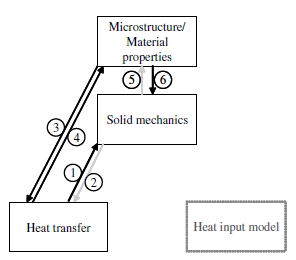Numerical modelling of welding - Lindgren
Welding simulation (computational welding mechanics) dates back to the 1970s
Model:
Simulation:
Validation:
Calibration:
Prediction:
Verification:
Qualification:
Couplings

- Thermal dilatation drives deformation
- Deformation generates small amount of heat
- Latent heat due to phase changes and thermal properties depend on microstructure and temperature
- Temperature drives microstructure changes
- Deformation affects microstructure changes
- Mechanical properties depends on microstructure
Fluid flow is not accounted for
High temperature region is approximated by a soft solid in mechanical analysis, a given heat input in thermal analysis, and sometimes a high conductivity for imitating convective heat transfer in the weld puddle
The most common approach is to split thermal analysis followed by mechanical analysis. This is a conditional stable.
There exists thermo-metallurgical-mechanical (TMM) analysis which is unconditional stable.
Reference frames
Updated Lagrangian
Eulerian
Thermal analysis
Energy relation from heat conduction



dst
Mechanical analysis
Scope of analysis and accuracy
Questions that may be scope of welding simulation. Sorted based on modellling complexity:
- What are the residual stresses
- What are the final deformations
- What are the transient stresses and deformations
- What is the microstructure of the weld and HAZ
- What causes hot cracking
Accuracy levels:
- Reduced accuracy levels: for evaluations at preliminary design stages
- Basic simulation: answer question 1 and 2
- Standard simulation: answer questions 1-3
- Accurate simulation: answer 1-4
- Very accurate simulation: answer 1-5
Level 1, 2 and 3 are well-established.
Geometric models

Heat input models
Analytical splutions mostly use Rosenthal's. Not appropriate for numerical in vicinity of weld area.
The Gaussian heat source model is appropriate for accurate analysis, needs at least four quadratic elements.
Material models
Applications
- Effect of residual stresses on intergranular stress corrosion cracking
- Calculating limiting pressure for welding a pipe with internal pressure
- Finding residual stress for fatigue analysis
- Design low stress low distortion welding techniques
- Reducing risk for cracking
- Predict distrotion due to welding
Improvement of modelling in CWM
Mostly concerned with heat input and material model aspects.
Created with the Personal Edition of HelpNDoc: Easily create PDF Help documents